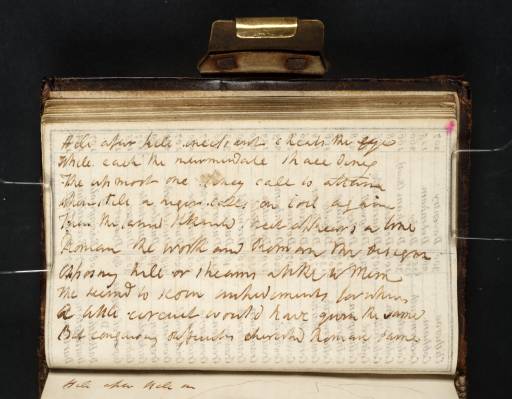Joseph Mallord William Turner Inscription by Turner: Draft of Poetry 1811
Joseph Mallord William Turner,
Inscription by Turner: Draft of Poetry
1811
Joseph Mallord William Turner 1775–1851
Folio 30 Verso:
Inscription by Turner: Draft of Poetry 1811
D08418
Turner Bequest CXXIII 30a
Turner Bequest CXXIII 30a
Inscribed by Turner in ink (see main catalogue entry) on white wove printing paper, 75 x 117 mm
Accepted by the nation as part of the Turner Bequest 1856
References
1862
Walter Thornbury, The Life of J.M.W. Turner, R.A. Founded on Letters and Papers Furnished by his Friends and Fellow-Academicians, London 1862, vol.II, pp.18–19.
1897
Walter Thornbury, The Life of J.M.W. Turner, R.A. Founded on Letters and Papers Furnished by his Friends and Fellow-Academicians: A New Edition, Revised with 8 Coloured Illustrations after Turner’s Originals and 2 Woodcuts, London 1897, p.207.
1909
A.J. Finberg, A Complete Inventory of the Drawings of the Turner Bequest, London 1909, vol.I, p.346, CXXIII 30a, as ‘Verses’.
1966
Jack Lindsay, The Sunset Ship: The Poems of J.M.W. Turner, Lowestoft 1966, pp.109–10.
1990
Andrew Wilton and Rosalind Mallord Turner, Painting and Poetry: Turner’s ‘Verse Book’ and his Work of 1804–1812, exhibition catalogue, Tate Gallery, London 1990, p.170.
1997
James Hamilton, Turner: A Life, London 1997, p.143.
2003
James Hamilton, Turner’s Britain, exhibition catalogue, Gas Hall, Birmingham Museums & Art Gallery 2003, p.100.
The whole page is taken up with the following lines of verse:
Hill after hill incessant cheats the eye
While each the intermediate space deny
The upmost one long call to attain
When still a higher calls on toil again
Then the famed Icknield Street appears a line
Roman the work and Roman the design
Opposing hill or streams alike to them
The [i.e. ‘They’] seemed to scorn impediments for when
A little circuit would have given the same
But conquering difficulties cherishd Roman fame1
While each the intermediate space deny
The upmost one long call to attain
When still a higher calls on toil again
Then the famed Icknield Street appears a line
Roman the work and Roman the design
Opposing hill or streams alike to them
The [i.e. ‘They’] seemed to scorn impediments for when
A little circuit would have given the same
But conquering difficulties cherishd Roman fame1
Interspersed with drawings and the printed pages of Coltman’s British Itinerary, sixty-nine pages of this sketchbook are given over wholly or partly to these verses which Turner intended as a commentary for publication with the Picturesque Views on the Southern Coast of England which he sketched on the 1811 West Country tour (see the introduction to the sketchbook). The first lines are on folio 18 verso (D08396), and the last on folio 207 verso (D08736; CXXIII 204a).
As a means of adding historical perspective to his own journey, Turner names ‘Icknield Street’ and refers to the Romans, apparently in relation to one of the Roman roads converging from the east on Old Sarum, near Salisbury. It has been observed that ‘several widely separated Roman roads have been called Icknield Street, which has led to some confusion with the Icknield Way’,2 generally understood as a pre-Roman track from East Anglia towards the West Country, the exact route of which remains open to interpretation. James Hamilton sees the first two lines as showing, among his ‘different characteristics’, Turner ‘the knowing topographer’,3 while the passage in general ‘evokes movement, history and manufacture of civilisation’.4
Matthew Imms
June 2011
See transcriptions (followed here with slight variations) in Lindsay 1966, pp.109–10, as part of ‘Barrows and Roman Road’, section (d) of poem no.50, ‘On the Western Itinerary 1811’, and Wilton and Turner 1990, p.170, as also given in Hamilton 1997, p.143; first two lines only given in Hamilton 2003, p.100; previously transcribed with variations in Thornbury 1862, II, pp.18–19 and 1897, p.207.
How to cite
Matthew Imms, ‘Inscription by Turner: Draft of Poetry 1811 by Joseph Mallord William Turner’, catalogue entry, June 2011, in David Blayney Brown (ed.), J.M.W. Turner: Sketchbooks, Drawings and Watercolours, Tate Research Publication, December 2012, https://www

